Investigation on Dynamic Responses’ Characteristics and Fatigue Damage Assessment for Floating Offshore Wind Turbine Structures
Abstract
1. Introduction
2. Distribution of Structural Dynamic Response Amplitudes
2.1. Gaussian Distribution
2.2. Rayleigh Distribution
2.3. Weibull Distribution
2.4. Dirlik Distribution
2.5. Tovo and Benasciutti Method
3. Fatigue Damage Assessment Method
3.1. Spectral Analysis Method
- Narrow-band solution (Rayleigh)
- 2.
- Dirlik method
- 3.
- Tovo–Benasciutti method
3.2. Time-Domain Analysis Method
4. Wind Turbine Models
4.1. NREL 5 MW Wind Turbine
4.2. OC3 Monopile Fixed OWT
4.3. OC3-Hywind Spar FOWT
5. Numerical Study
5.1. Environmental Condition
5.2. Coupled Dynamic Response in Time Domain
5.3. Analysis of Axial Stress at the Tower Base for Both Fixed and Floating OWT
5.3.1. Axial Stress Calculation
5.3.2. Spectrum Analysis of the Stress at Tower Base
5.3.3. Distribution of Axial Stress Amplitudes of Tower Base
5.4. Analysis of Mooring Line Tension for FOWT
5.4.1. Non-Gaussian Characteristics of Mooring Line Tension Responses
5.4.2. Distribution of Mooring Line Tension Amplitudes
5.5. Fatigue Damage Assessments of OWT Structures
5.5.1. Fatigue Damage Assessment of the Tower Base
5.5.2. Fatigue Damage Assessment of Mooring System
6. Conclusions
- For the tower base of both fixed and floating OWTs, the dominated excitation frequencies of the stress responses are different. For the fixed structure, it is more sensitive to the excitation generated by the rotation of the wind turbine, while for the floating structure, the structure response is more sensitive to the low-frequency wave excitation.
- The non-Gaussianity of the mooring line tension response is obvious under most of the sea states. Research results show that the non-Gaussian nature of mooring line tension is mainly caused by low-frequency components, while wave-frequency components have little effect on it.
- The traditional Rayleigh distribution cannot fit both of the stress amplitude of the tower base and tension amplitude of mooring line distribution. Among several candidates of distribution models, the Dirlik distribution has a better performance to describe the statistical characteristics of the FOWT dynamic response.
- For the fatigue damage assessment, the traditional spectrum analysis method based on the Rayleigh distribution will no longer be applicable to offshore wind turbine structures. This method will overestimate the fatigue damage of the structure to a great extent, while the spectral fatigue damage model with Dirlik distribution shows the close results with those from the time-domain method, indicating that the distribution is suitable for the fatigue damage assessments of FOWTs.
Author Contributions
Funding
Institutional Review Board Statement
Informed Consent Statement
Data Availability Statement
Conflicts of Interest
References
- Jonkman, J. Dynamics Modeling and Loads Analysis of an Offshore Floating wind Turbine; NREL/TP-500-41959; National Renewable Energy Laboratory: Golden, CO, USA, 2007.
- Ren, Y.; Venugopal, V.; Shi, W. Dynamic analysis of a multi-column TLP floating offshore wind turbine with tendon failure scenarios. Ocean Eng. 2022, 245, 110472. [Google Scholar] [CrossRef]
- Zhang, Y.; Shi, W.; Li, D.; Li, X.; Duan, Y.; Verma, A.S. A novel framework for modeling floating offshore wind turbines based on the vector form intrinsic finite element (VFIFE) method. Ocean Eng. 2022, 262, 112221. [Google Scholar] [CrossRef]
- Feng, K.; Ji, J.C.; Ni, Q. A novel adaptive bandwidth selection method for Vold–Kalman filtering and its application in wind turbine planetary gearbox diagnostics. Struct. Health Monit. 2022, 475–501. [Google Scholar] [CrossRef]
- Ariduru, S. Fatigue Life Calculation by Rainflow Cycle Counting Method. Master’s Thesis, Middle East Technical University, Ankara, Turkey, 2004. [Google Scholar]
- Yeter, B.; Garbatov, Y.; Guedes Soares, C. Evaluation of fatigue damage model predictions for fixed offshore wind turbine support structures. Int. J. Fatigue 2016, 87, 71–80. [Google Scholar] [CrossRef]
- Gao, Z.; Moan, T. Frequency-domain fatigue analysis of wide-band stationary Gaussian processes using a trimodal spectral formulation. Int. J. Fatigue 2008, 30, 1944–1955. [Google Scholar] [CrossRef]
- Li, H.; Du, J.; Wang, S.; Sun, M.; Chang, A. Investigation on the probabilistic distribution of mooring line tension for fatigue damage assessment. Ocean Eng. 2016, 124, 204–214. [Google Scholar] [CrossRef]
- Wirsching, P.H.; Light, M.C. Fatigue under wide band random stresses. J. Struct. Div. 1980, 106, 1593–1607. [Google Scholar] [CrossRef]
- Rice, S.O. Mathematical analysis of random noise. Bell Syst. Tech. J. 1945, 24, 46–156. [Google Scholar] [CrossRef]
- Dirlik, T. Application of Computers in Fatigue Analysis. Ph.D. Thesis, University of Warwick, Coventry, UK, 1985. [Google Scholar]
- Oritz, K.; Chen, N.K. Fatigue damage prediction for stationary wide-band stresses. In Proceedings of the 5th International Conference on the Applications of Statistics and Probability in Civil Engineering, Vancouver, BC, Canada, 8–12 June 1987. [Google Scholar]
- Kim, B.; Wang, X.Z.; Shin, Y.S. Extreme load and fatigue damage on FPSO in combined waves and swells. In Proceedings of the 10th International Symposium on Practical Design of Ships and Other Floating Structures, Houston, TX, USA, 1–5 October 2007. [Google Scholar]
- Benasciutti, D.; Tovo, R. Spectral methods for lifetime prediction under wide-band stationary random processes. Int. J. Fatigu. 2005, 27, 867–877. [Google Scholar] [CrossRef]
- Gao, Z.; Moan, T. Fatigue damage induced by nongaussian bimodal wave loading in mooring lines. Appl. Ocean Res. 2007, 29, 45–54. [Google Scholar] [CrossRef]
- Jiao, G.; Moan, T. Probabilistic Analysis of Fatigue Due to Gaussian Load Process. Probab. Eng. Mech. 1990, 5, 76–83. [Google Scholar] [CrossRef]
- Park, J.-B.; Chang, Y.S. Fatigue damage model comparison with formulated tri-modal spectrum loadings under stationary gaussian random processes. Ocean Eng. 2015, 105, 72–82. [Google Scholar] [CrossRef]
- Dong, W.; Moan, T.; Gao, Z. Long-term fatigue analysis of multi-planar tubular joints for jacket-type offshore wind turbine in time domain. Eng. Struct. 2001, 33, 2002–2014. [Google Scholar] [CrossRef]
- American Bureau of Shipping. Guide for the Fatigue Assessment of Offshore Structures; American Bureau of Shipping (ABS): Houston, TX, USA, 2003. [Google Scholar]
- API Recommended Practice2SK(RP2SK). Recommended Practice for Design and Analysis of Station Keeping Systems for Floating Structures: Exploration and Production Department; American Petroleum Institute: Washington, DC, USA, 2005. [Google Scholar]
- Miner, M.A. Cumulative damage in fatigue. J. Appl. Mech. 1945, 12, 159–164. [Google Scholar] [CrossRef]
- Rychlik, I. On the ‘narrow-band’ approximation for expected fatigue damage. Int. J. Fatigue 1994, 16, 235. [Google Scholar] [CrossRef]
- Tovo, R. Cycle distribution and fatigue damage under broad-band random loading. Int. J. Fatigue 2002, 24, 1137–1147. [Google Scholar] [CrossRef]
- Matsuishi, M.; Endo, T. Fatigue of metals subjected to varying stress. Jpn. Soc. Mech. Eng. 1968, 96, 100–103. [Google Scholar]
- Du, J.; Chang, A.; Wang, S.; Sun, M.; Wang, J.; Li, H. Multi-mode reliability analysis of mooring system of deep-water floating structures. Ocean Eng. 2019, 192, 106517. [Google Scholar] [CrossRef]
- DNV DNV-RP-C203. Fatigue Design of Offshore Steel Structures; DNV: Oslo, Norway, 2010. [Google Scholar]
- Jonkman, J.; Butterfield, S.; Musial, W. Definition of a 5-MW Reference Wind Turbine for Offshore System Development; National Renewable Energy Lab: Golden, CO, USA, 2009.
- Jonkman, J.; Musial, W. Offshore Code Comparison Collaboration (OC3) for IEA Wind Task 23 Offshore Wind Technology and Deployment; National Renewable Energy Lab: Golden, CO, USA, 2010.
- Johannessen, K.; Meling, T.S.; Haver, S. Joint distribution for wind and waves in the northern northsea. Int. J. Offshore Polar Eng. 2002, 12, 1–8. [Google Scholar]
- Jonkman, J. Definition of the Floating System for Phase IV of OC3; National Renewable Energy Lab: Golden, CO, USA, 2010.
- Jonkman, B.; Jonkman, J. ReadMe File for FAST v8; National Renewable Energy Laboratory: Golden, CO, USA, 2014.
- Ciang, C.C.; Lee, J.R.; Bang, H.J. Structural health monitoring for a wind turbine system: A review of damage detection methods. Meas. Sci. Technol. 2008, 19, 310–314. [Google Scholar] [CrossRef]
- Kvittem, M.I.; Moan, T. Frequency versus time domain fatigue analysis of a semisubmersible wind turbine tower. J. Offshore Mech. Arct. Eng. 2015, 137, 011901.1–011901.11. [Google Scholar] [CrossRef]
- Kvittem, M.I.; Moan, T. Time domain analysis procedures for fatigue assessment of a semi-submersible wind turbine. Mar. Struct. 2015, 40, 38–59. [Google Scholar] [CrossRef]
- Li, H.; Hu, Z.; Wang, J.; Meng, X. Short-term fatigue analysis for tower base of a spar-type wind turbine under stochastic wind-wave loads. Int. J. Nav. Archit. Ocean Eng. 2018, 10, 9–20. [Google Scholar] [CrossRef]
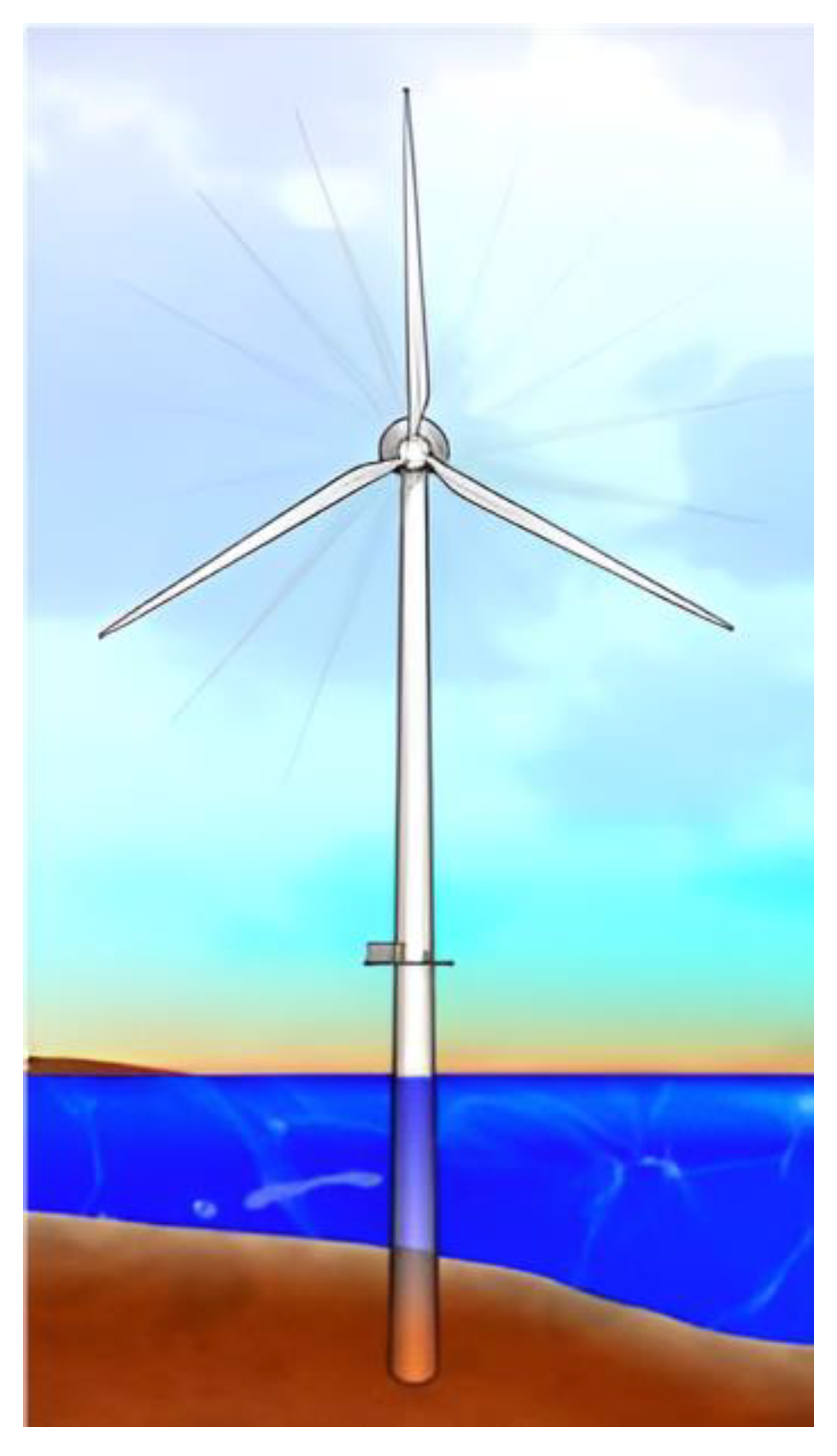
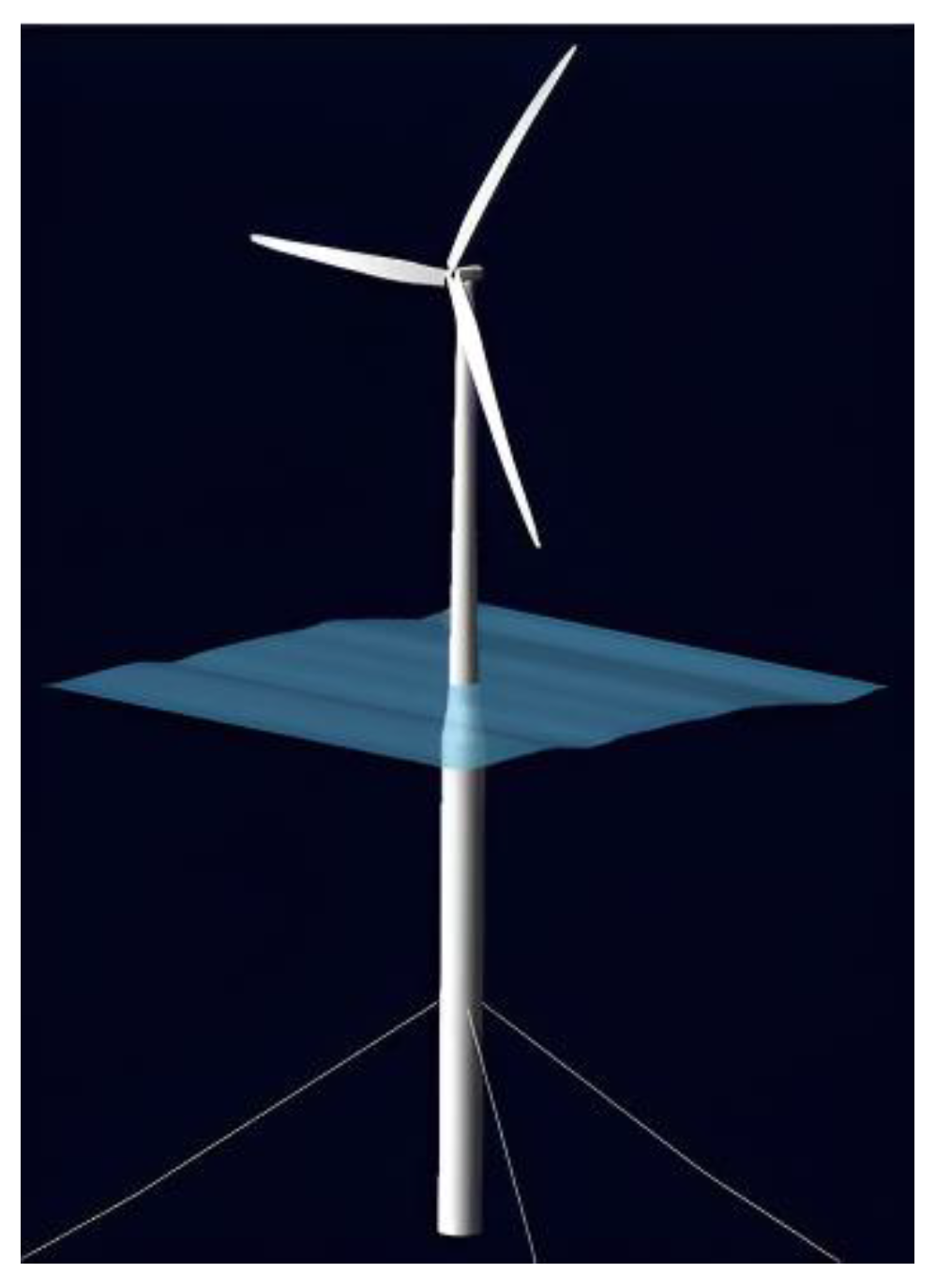
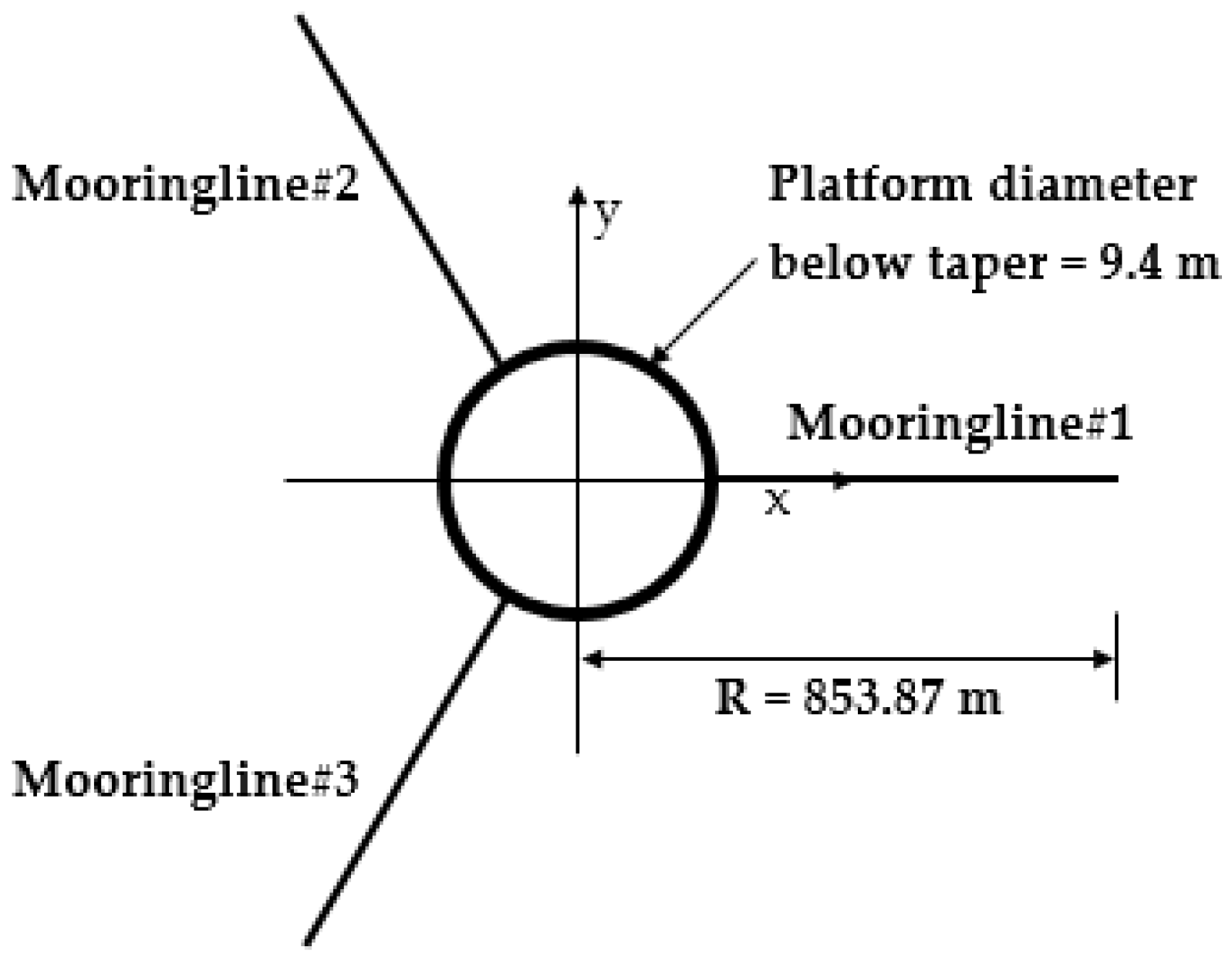

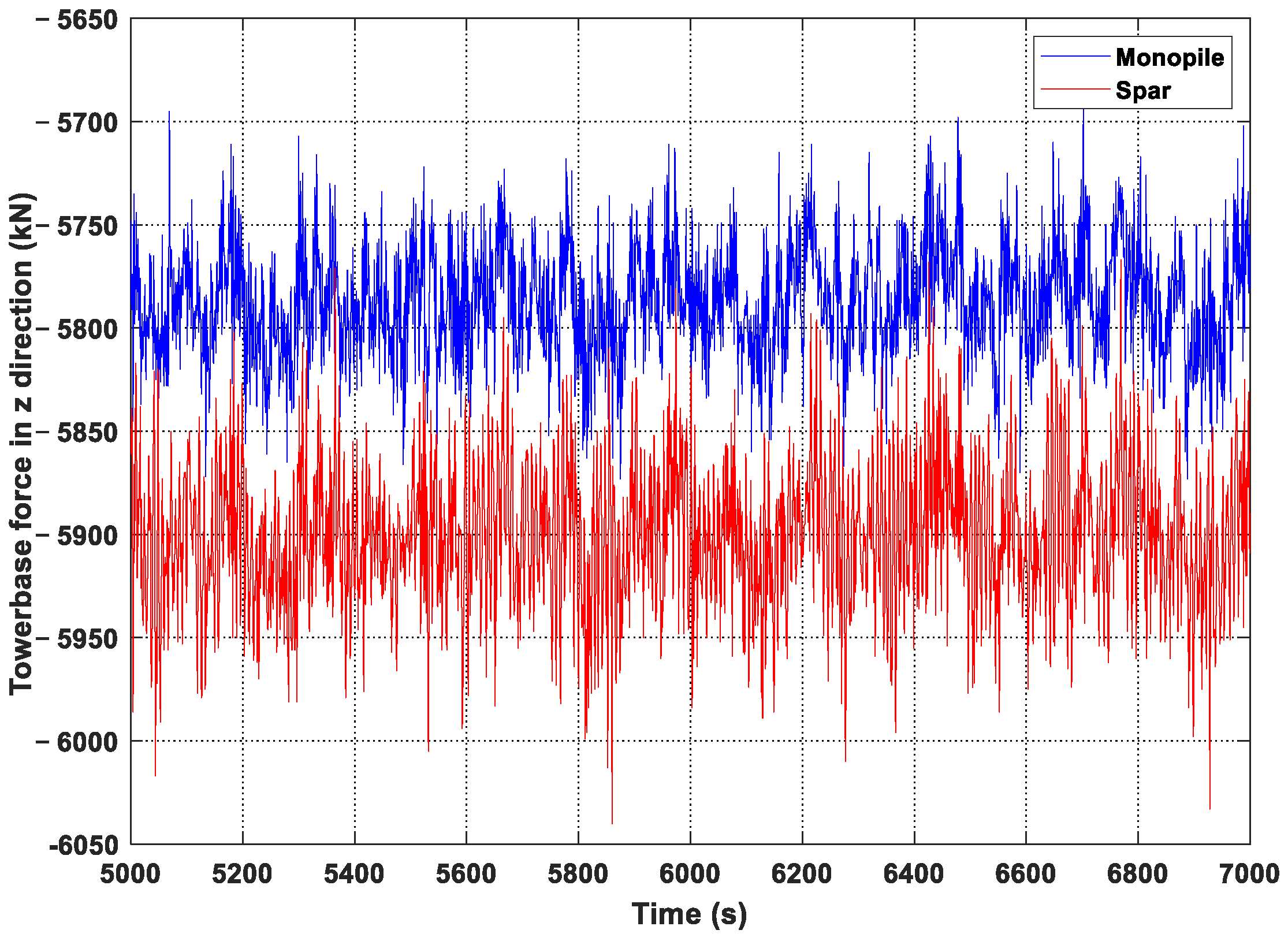
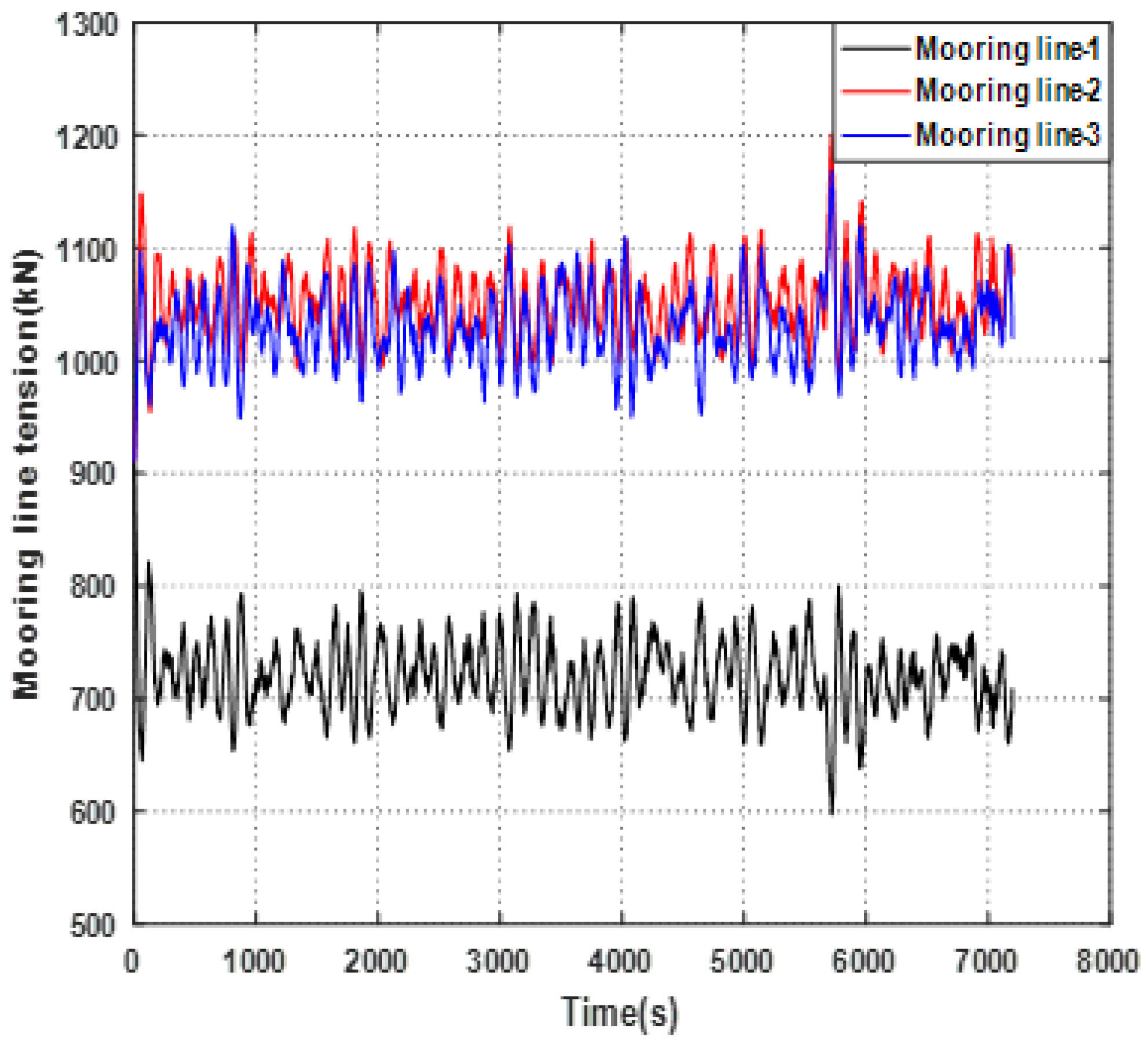
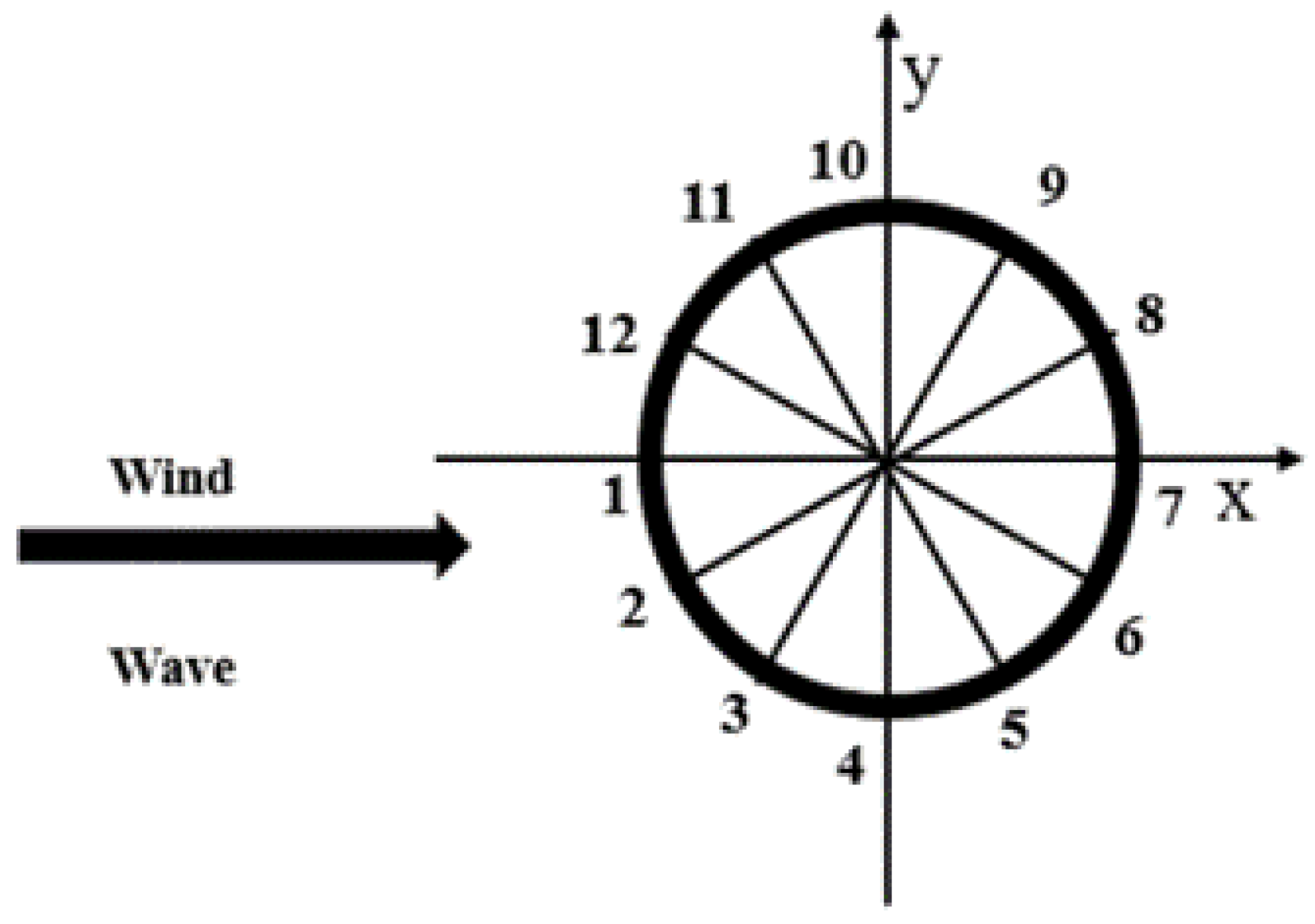
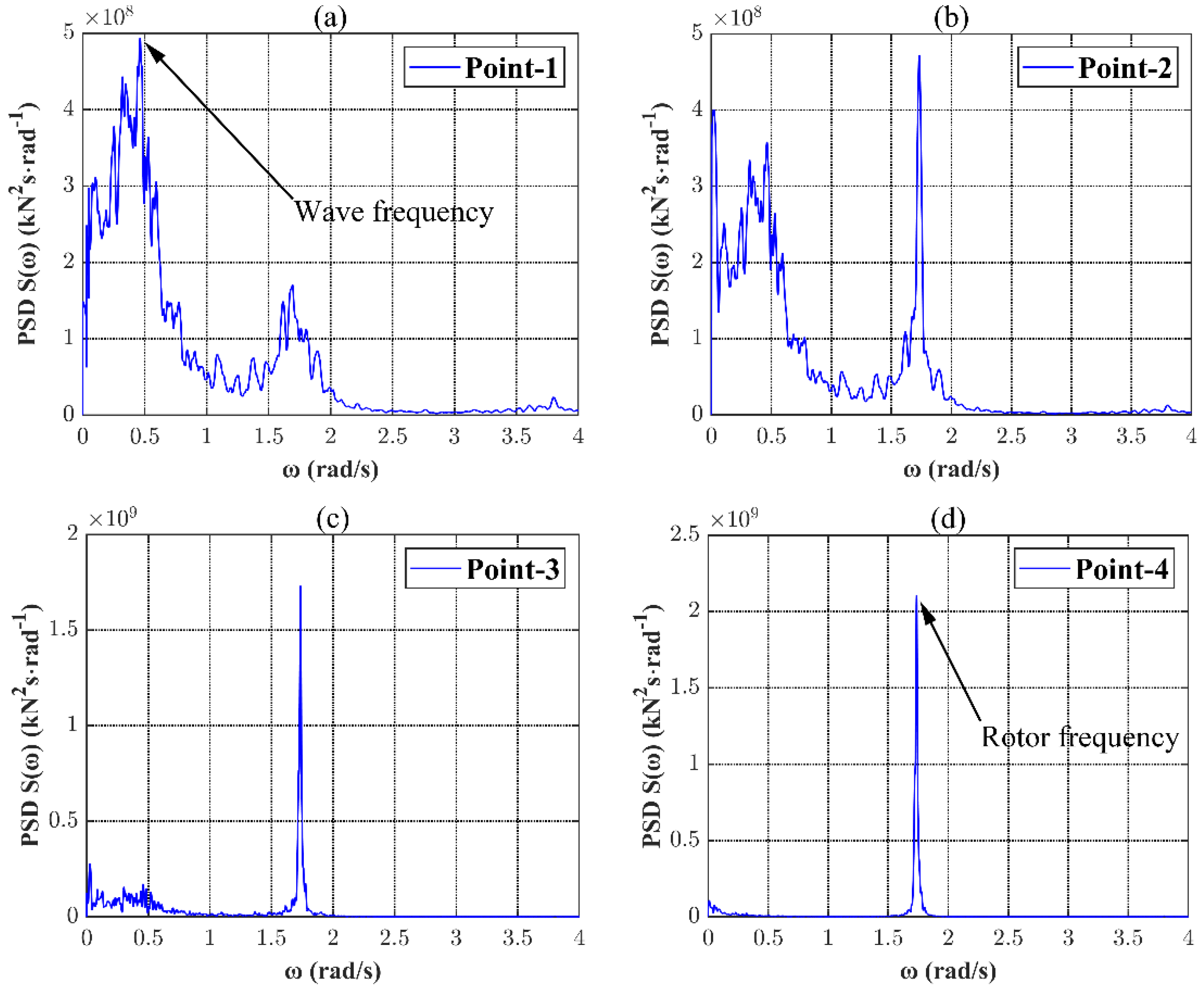
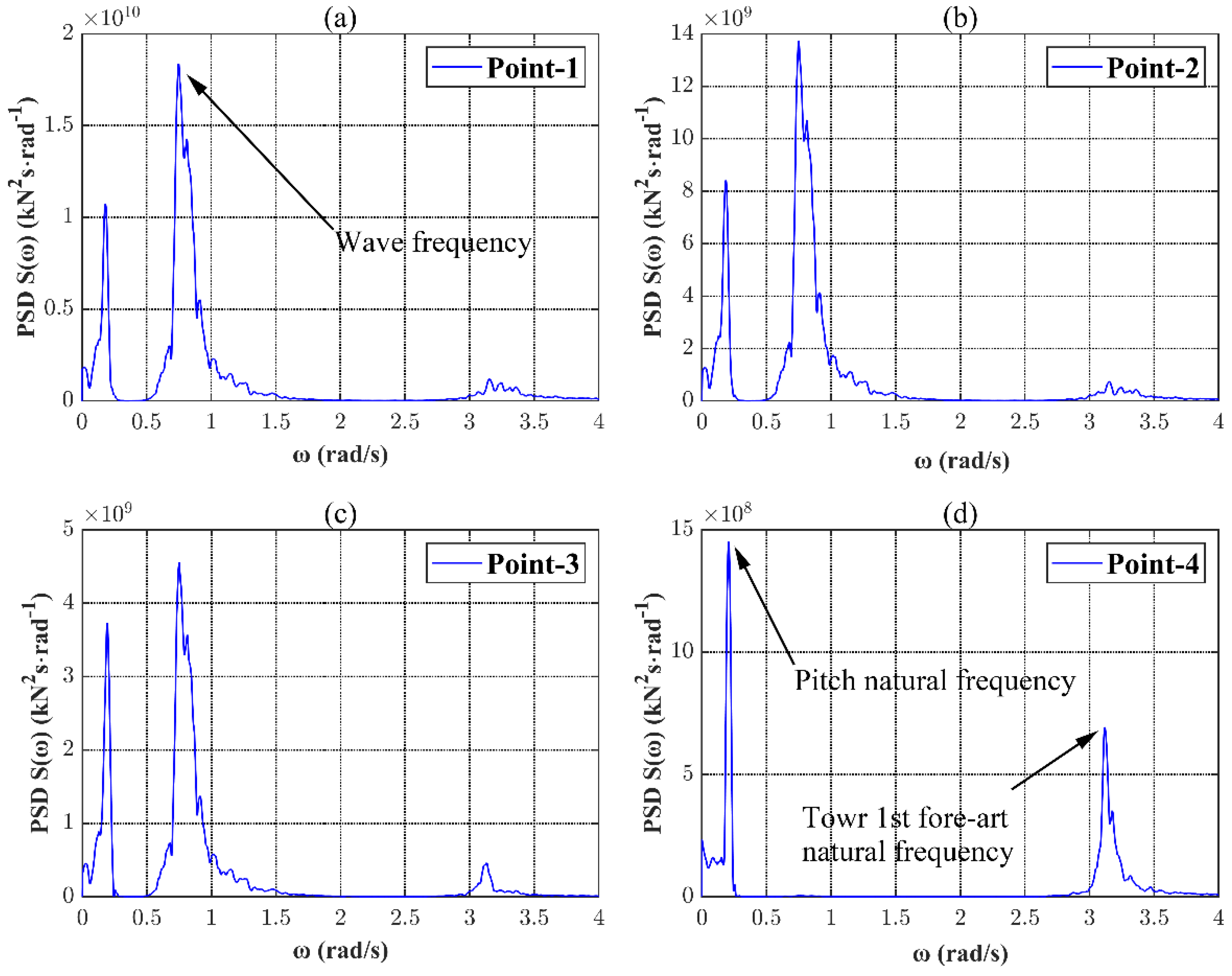
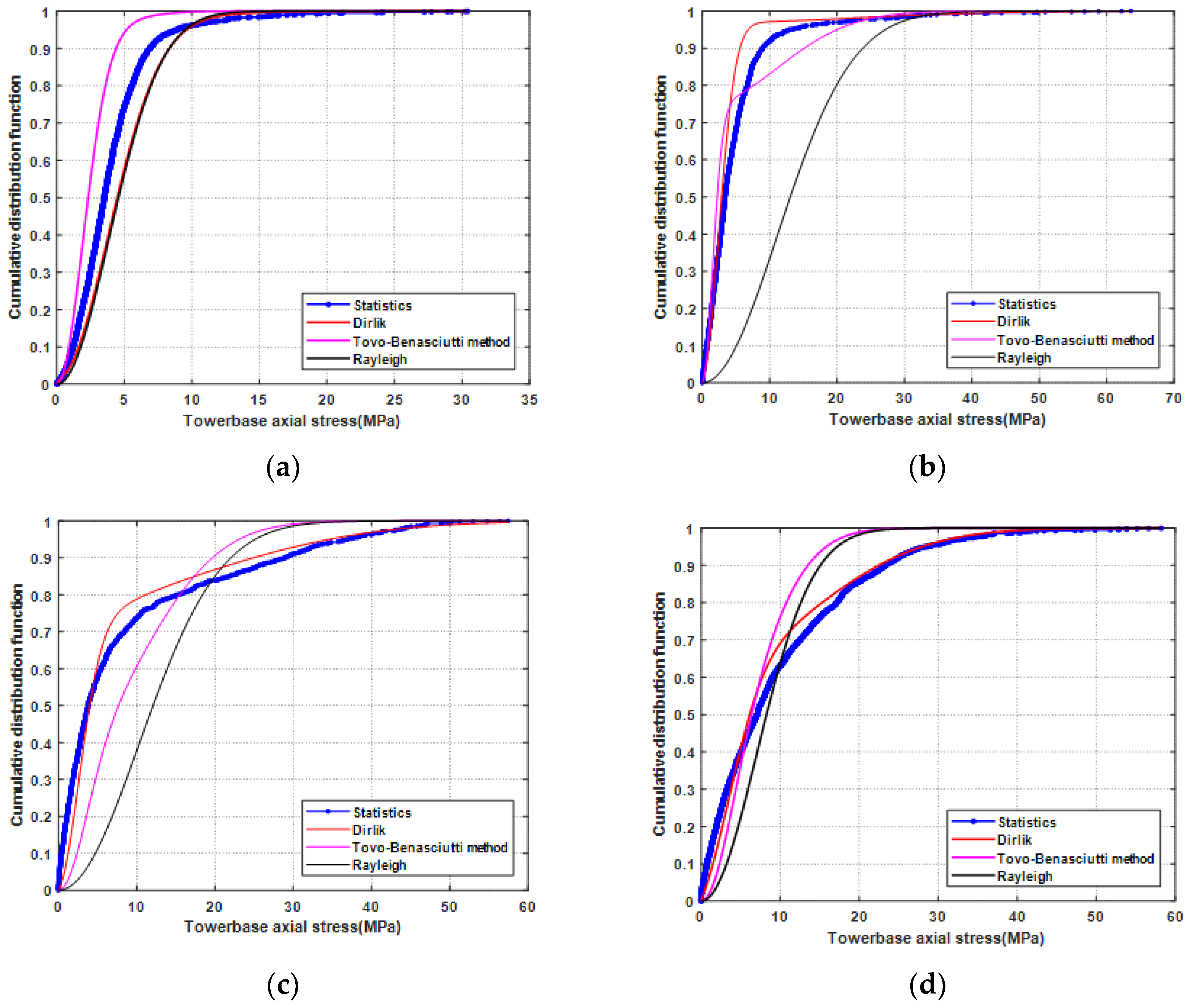
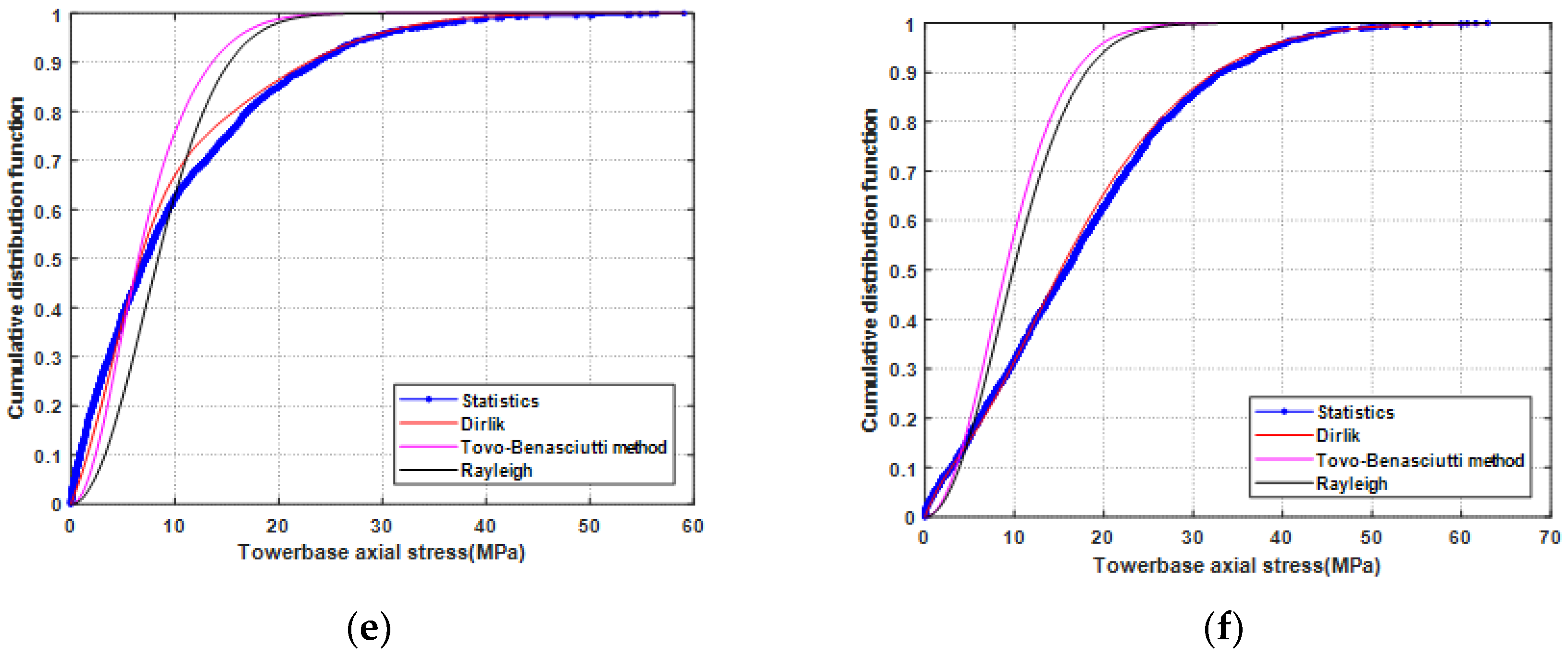

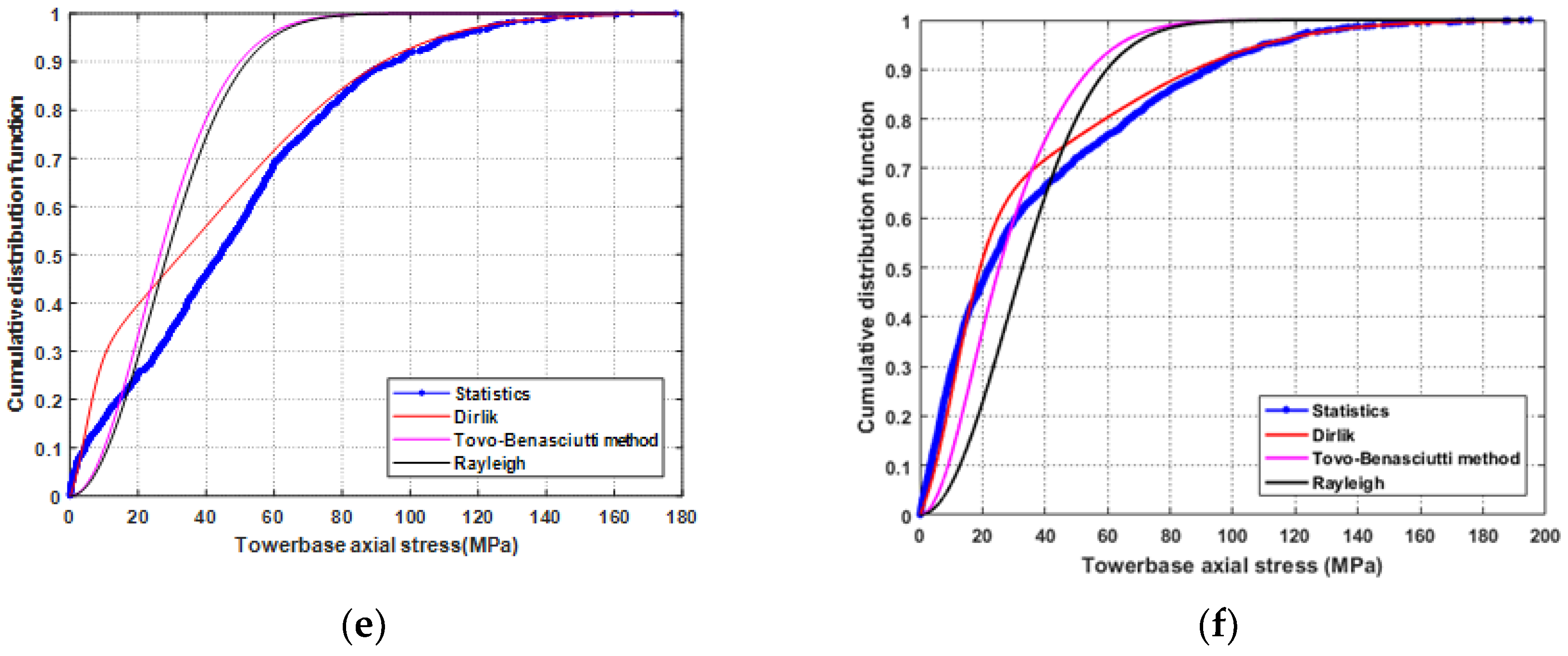
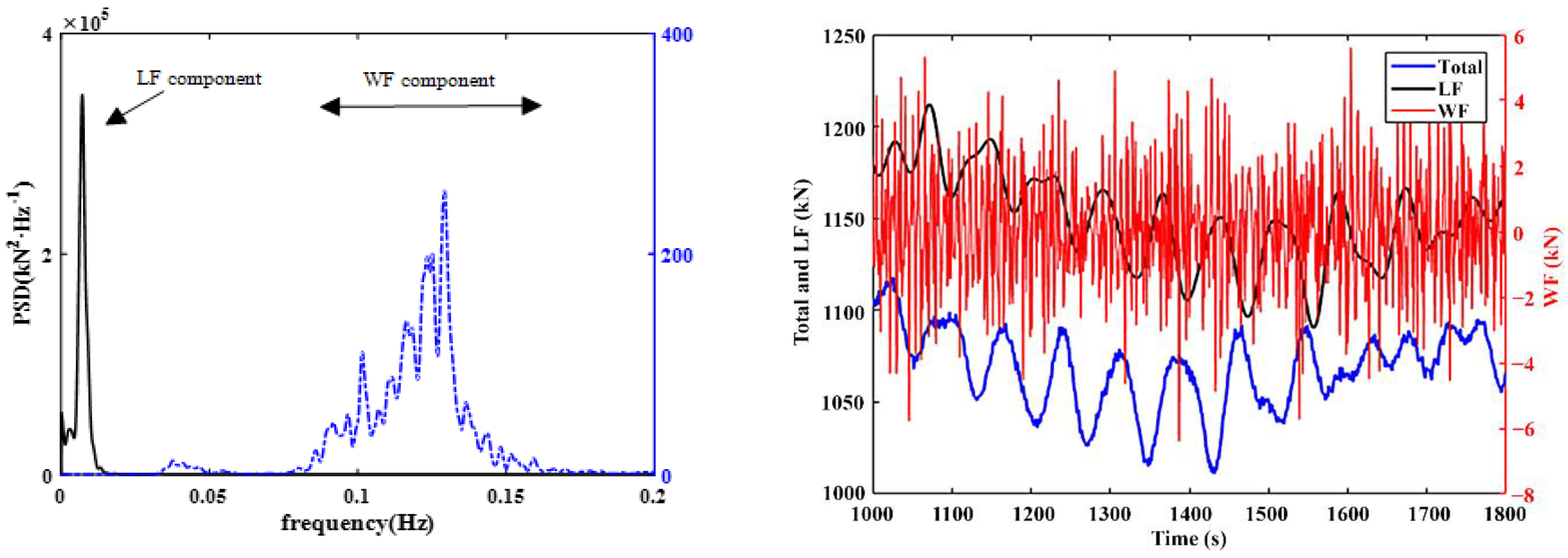

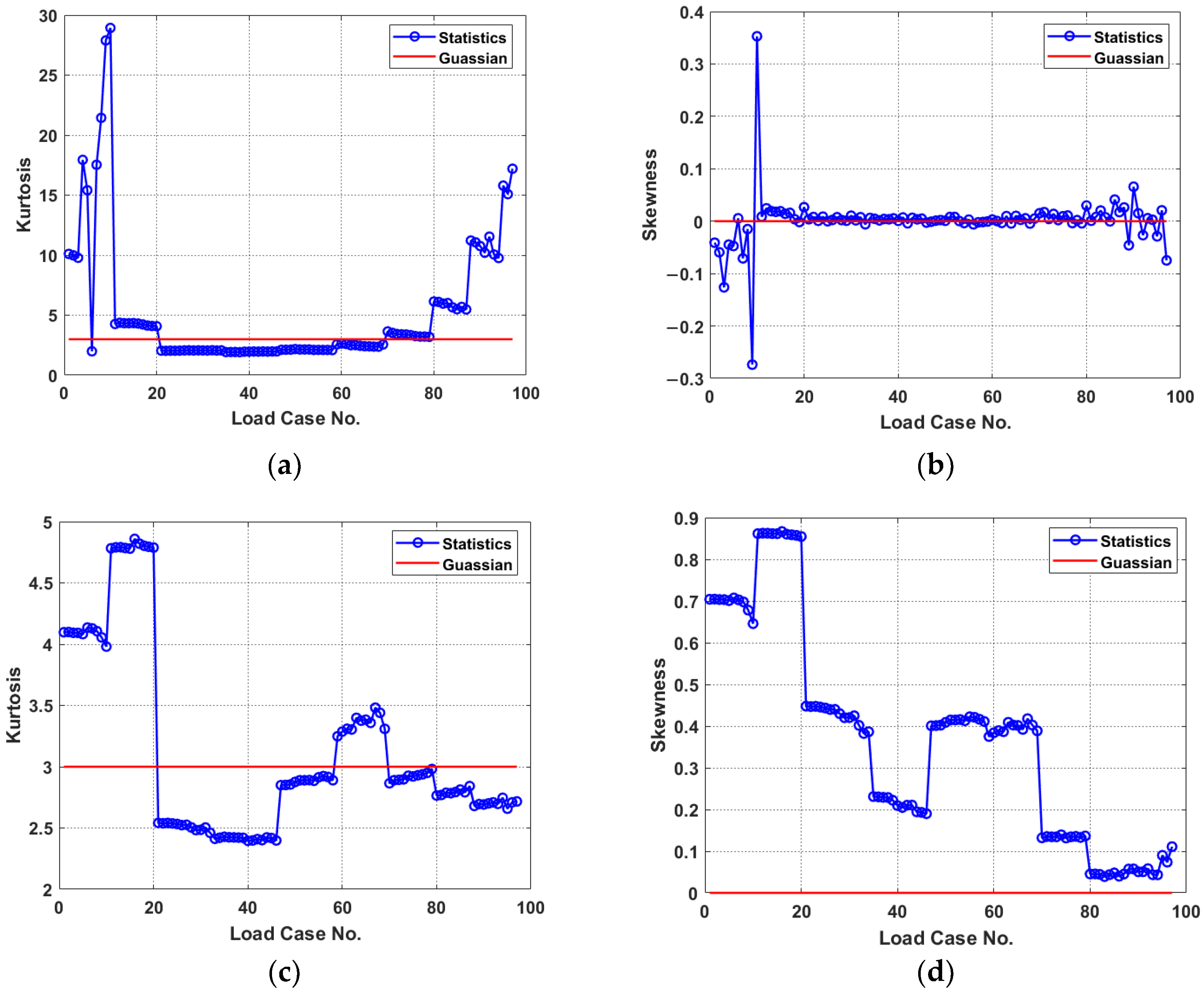
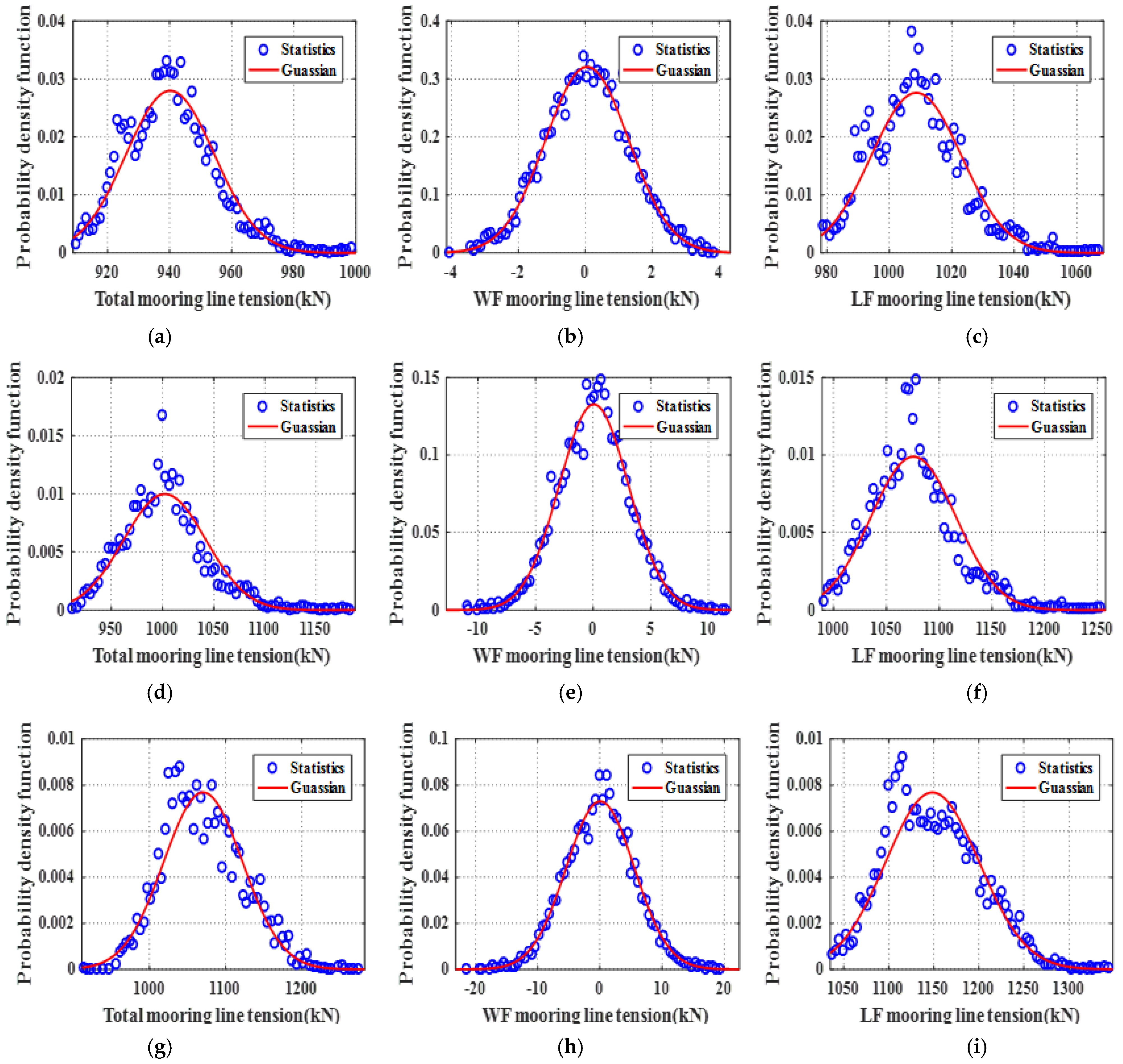
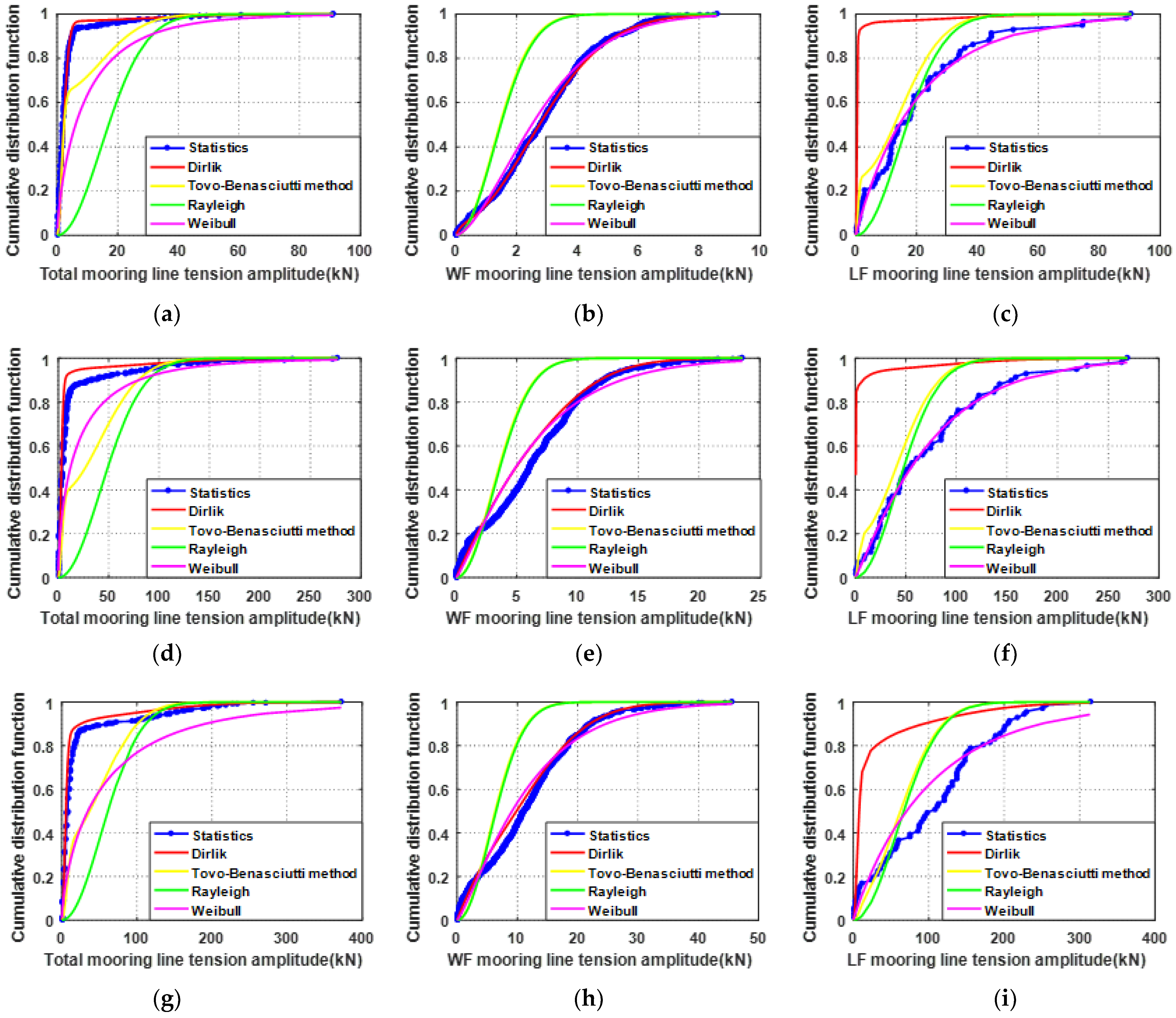
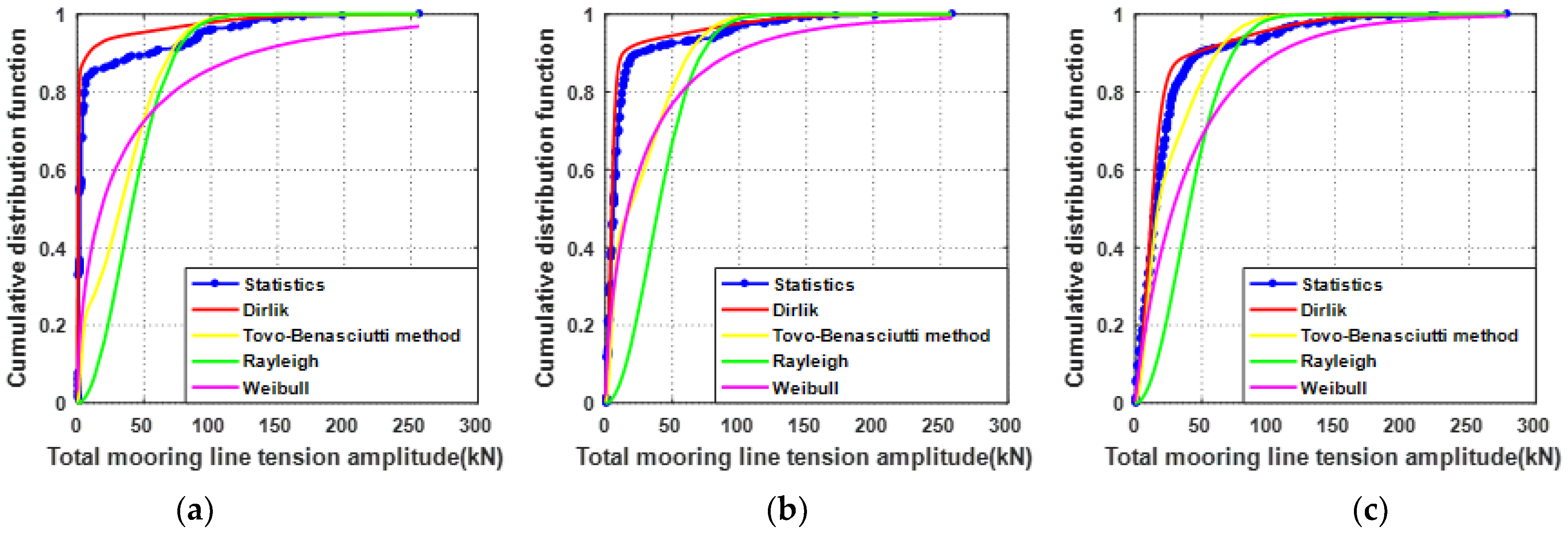
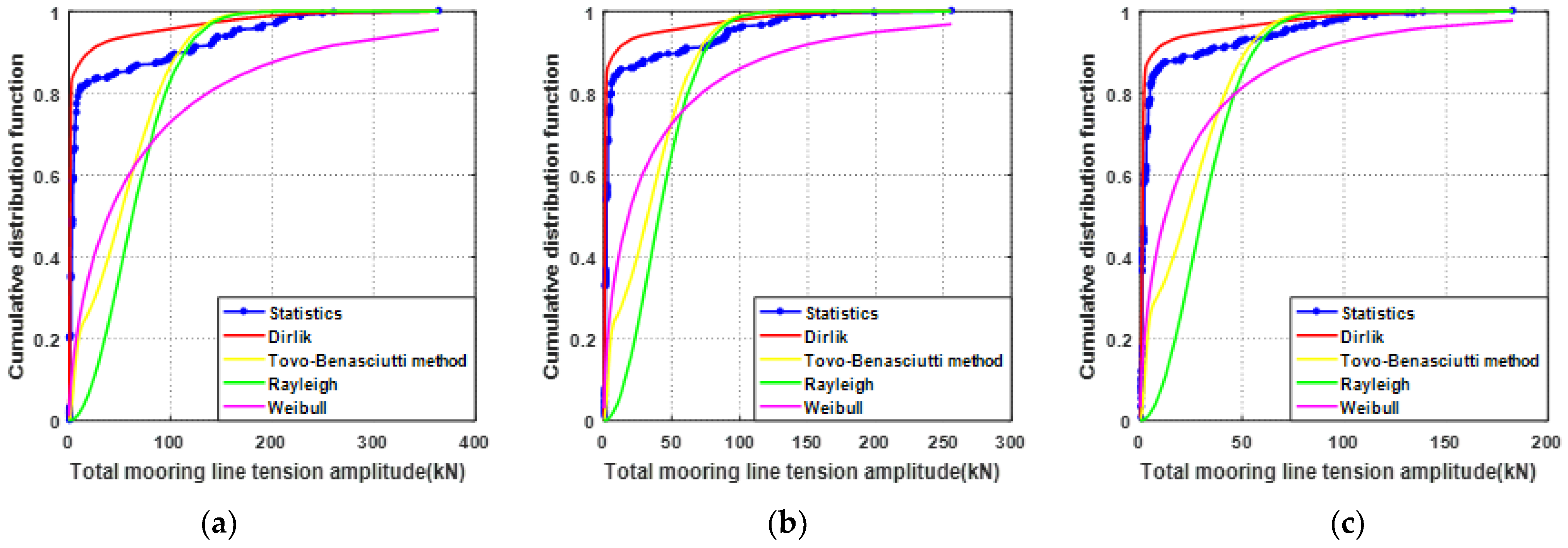
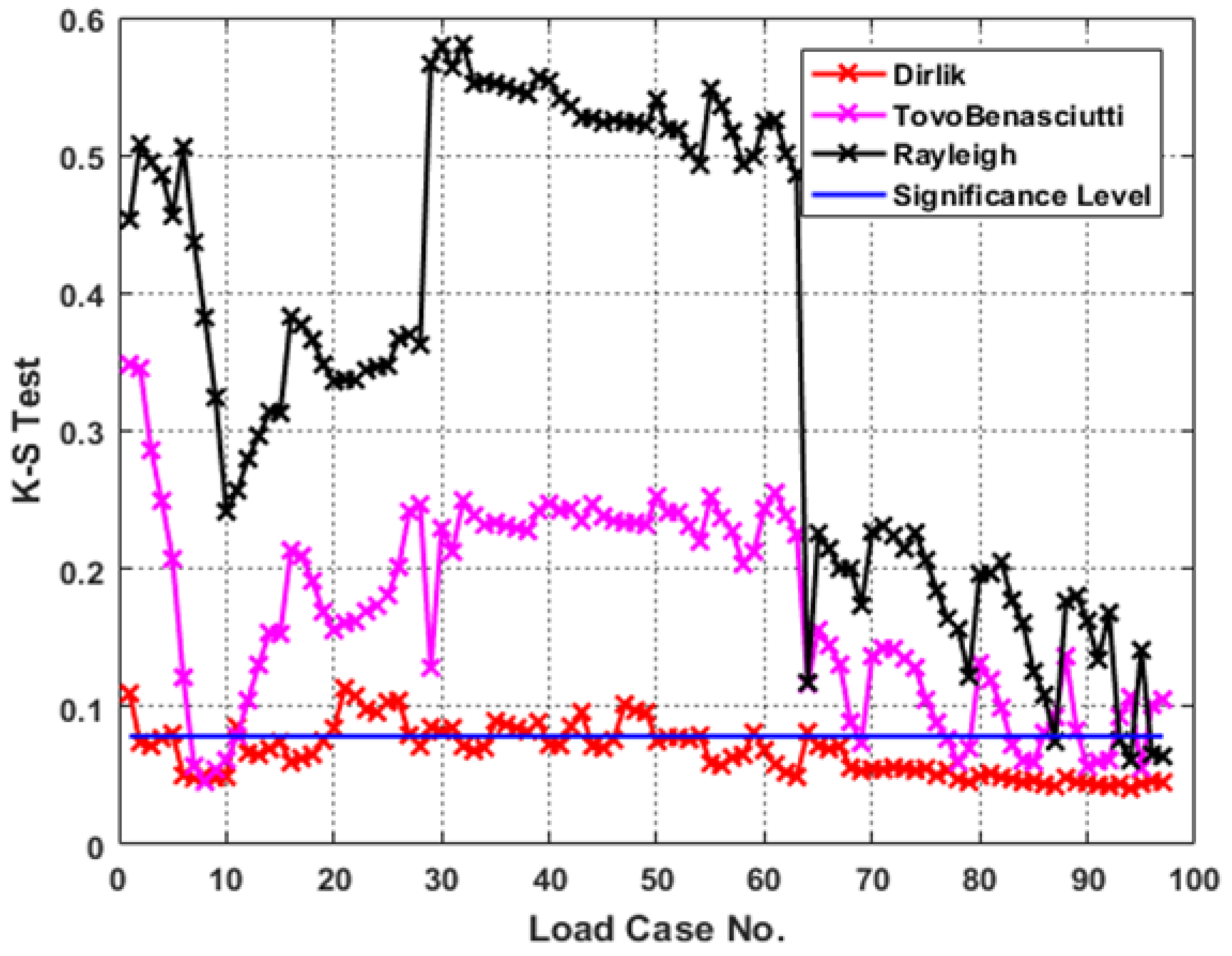
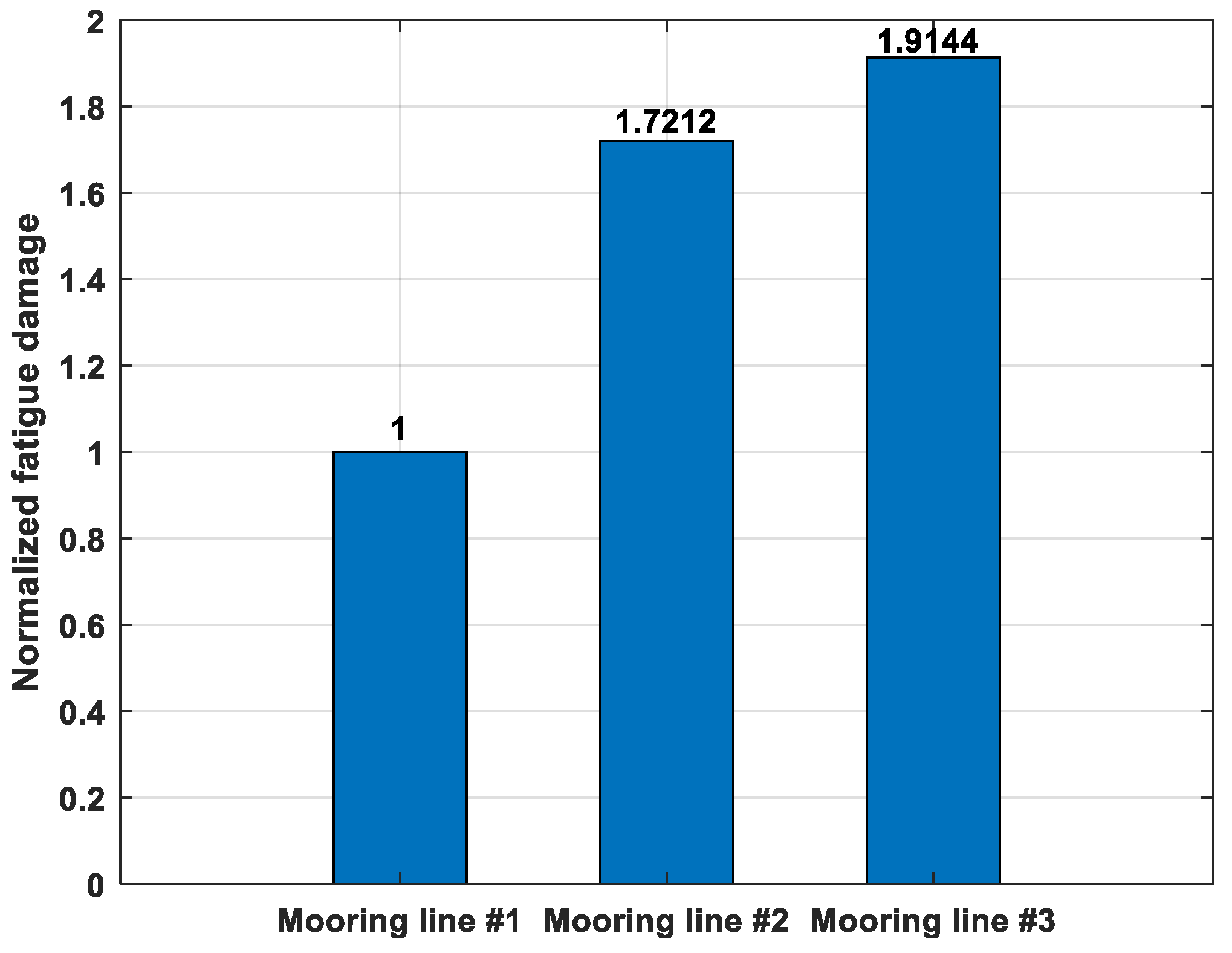
| Parameter | Values |
|---|---|
| Rating | 5 MW |
| Rotor Orientation, Configuration Control | Upwind, 3 Blades |
| Drivetrain | Variable Speed, Collective Pitch Gearbox |
| Rotor Diameter, Hub Diameter Hub Height | 126 m, 3 m 90 m |
| Cut-In, Rated, Cut-Out Wind Speed | 3 m/s, 11.4 m/s, 25 m/s |
| Cut-In, Rated Rotor Speed | 6.9 rpm, 12.1 rpm |
| Rotor Mass | 110 t |
| Nacelle Mass | 240 t |
| Tower Mass | 347.46 t |
| Parameter | Values |
|---|---|
| Height of tower | 87.6 m |
| Monopile length above water surface | 10 m |
| Depth of seawater | 20 m |
| Monopile length buried in soil | 45 m |
| Diameter of top and bottom of tower | 3.87 m and 6 m |
| Thickness of top and bottom of tower | 0.019 m and 0.027 m |
| Diameter and thickness of monopile | 6 m and 0.06 m |
| Density, young’s modules and shear modules of tower | 8500 kg/m³, 210 GPa and 80.8 GPa |
| Density, young’s modules and shear modules of monopile | 7850 kg/m³, 210 GPa and 80.8 GPa |
| Parameter | Values |
|---|---|
| Depth to platform base below SWL (total draft) | 120 m |
| Elevation to platform top (tower base) above SWL | 10 m |
| Depth to top of taper below SWL | 4 m |
| Depth to bottom of taper below SWL | 12 m |
| Platform diameter above taper | 6.5 m |
| Platform diameter below taper | 9.4 m |
| Platform mass, including ballast | 7,466,330 kg |
| CM location below SWL along platform centerline | 89.9155 m |
| Water depth | 320 m |
| Parameter | Values |
|---|---|
| Depth to anchors below SWL (water depth) | 320 m |
| Depth to fairleads below SWL | 70 m |
| Radius to anchors from platform centerline | 853.87 m |
| Radius to fairleads from platform centerline | 5.2 m |
| Unstretched mooring line length | 902.2 m |
| Mooring line diameter | 0.09 m |
| Equivalent mooring line mass density | 77.7066 kg/m |
| Equivalent mooring line weight in water | 698.094 N/m |
| Equivalent mooring line extensional stiffness | 384,243,000 N |
| Load Case No. | ||||
|---|---|---|---|---|
| 1 | 2 | 1 | 6 | 2.18 |
| 33 | 6 | 5 | 12 | 0.38 |
| 45 | 8 | 5 | 12 | 1.01 |
| 59 | 12 | 1 | 6 | 0.15 |
| 64 | 12 | 5 | 8 | 0.16 |
| 94 | 18 | 7 | 14 | 0.19 |
| The Point | Fixed OWT | FOWT |
|---|---|---|
| Point 1 | 1 | 11.4945 |
| Point 2 | 0.5997 | 5.3973 |
| Point 3 | 0.1574 | 0.3777 |
| Point 4 | 0.0892 | 0.1249 |
| Point | Time Domain | Rayleigh | Dirlik | Tovo–Benasciutti |
|---|---|---|---|---|
| Point 1 | 1 | 1.3492 | 0.9236 | 0.9098 |
| Point 2 | 0.5997 | 0.7974 | 0.5927 | 0.5800 |
| Point 3 | 0.1574 | 0.1641 | 0.1559 | 0.1537 |
| Point 4 | 0.0892 | 0.0903 | 0.0890 | 0.0881 |
| Point | Time Domain | Rayleigh | Dirlik | Tovo–Benasciutti |
|---|---|---|---|---|
| Point 1 | 1 | 1.4294 | 0.9881 | 0.9584 |
| Point 2 | 0.4444 | 0.5975 | 0.4268 | 0.4136 |
| Point 3 | 0.0332 | 0.0415 | 0.0295 | 0.0285 |
| Point 4 | 0.0105 | 0.0152 | 0.0101 | 0.0099 |
| Line | Time Domain | Rayleigh | Dirlik | Tovo–Benasciutti |
|---|---|---|---|---|
| Line #1 | 1 | 1.1790 | 0.9815 | 0.9454 |
| Line #2 | 1.7212 | 1.9772 | 1.6331 | 1.5887 |
| Line #3 | 1.9144 | 2.2335 | 1.7869 | 1.7289 |
Publisher’s Note: MDPI stays neutral with regard to jurisdictional claims in published maps and institutional affiliations. |
© 2022 by the authors. Licensee MDPI, Basel, Switzerland. This article is an open access article distributed under the terms and conditions of the Creative Commons Attribution (CC BY) license (https://creativecommons.org/licenses/by/4.0/).
Share and Cite
Zhang, M.; Zhou, Z.; Xu, K.; Shi, Y.; Wu, Y.; Du, J. Investigation on Dynamic Responses’ Characteristics and Fatigue Damage Assessment for Floating Offshore Wind Turbine Structures. Sustainability 2022, 14, 12444. https://doi.org/10.3390/su141912444
Zhang M, Zhou Z, Xu K, Shi Y, Wu Y, Du J. Investigation on Dynamic Responses’ Characteristics and Fatigue Damage Assessment for Floating Offshore Wind Turbine Structures. Sustainability. 2022; 14(19):12444. https://doi.org/10.3390/su141912444
Chicago/Turabian StyleZhang, Min, Zhiji Zhou, Kun Xu, Yuanyuan Shi, Yanjian Wu, and Junfeng Du. 2022. "Investigation on Dynamic Responses’ Characteristics and Fatigue Damage Assessment for Floating Offshore Wind Turbine Structures" Sustainability 14, no. 19: 12444. https://doi.org/10.3390/su141912444
APA StyleZhang, M., Zhou, Z., Xu, K., Shi, Y., Wu, Y., & Du, J. (2022). Investigation on Dynamic Responses’ Characteristics and Fatigue Damage Assessment for Floating Offshore Wind Turbine Structures. Sustainability, 14(19), 12444. https://doi.org/10.3390/su141912444








